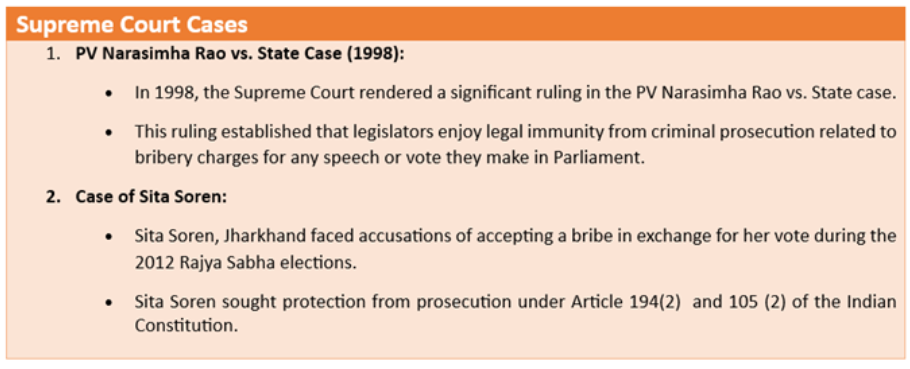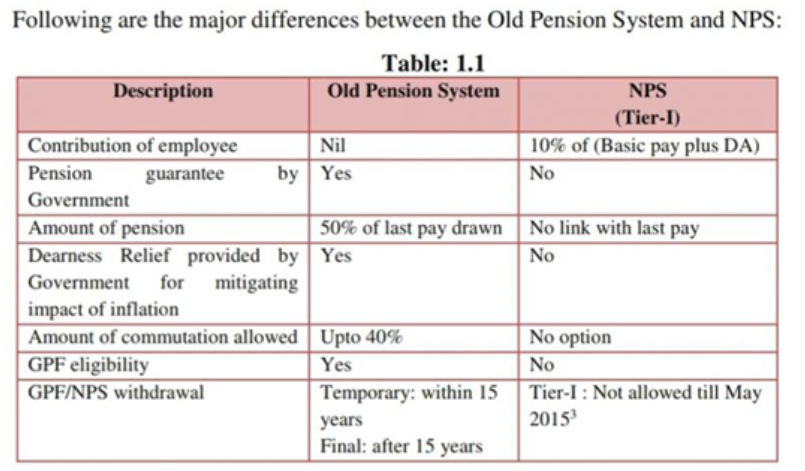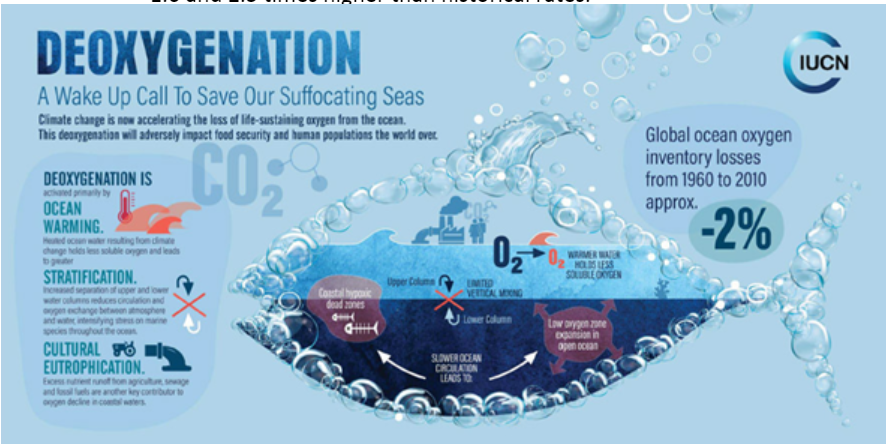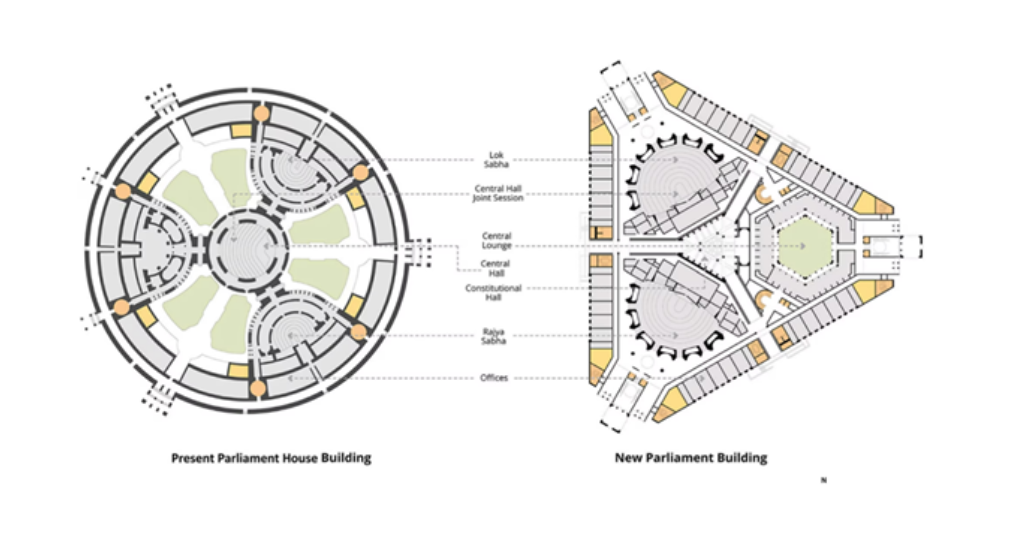Monday, 25th September 2023
India's Digital Landscape: PM-WANI
In News: The (PM-WANI) scheme is set to revolutionize public Wi-Fi in India. PM-WANI can be a potential game-changer for India’s digital public infrastructure.
About Digital Public Infrastructure
- DPI is a digital network that enables countries to safely and efficiently deliver economic opportunities and social services to all residents.
- DPI allows people to open bank accounts and receive wages faster and more easily. It allows governments to support citizens more quickly and efficiently, especially during emergencies. And it enables entrepreneurs to reach customers far and wide.
- DPI can be compared to roads, which form a physical network that connects people and provides access to a huge range of goods and services.
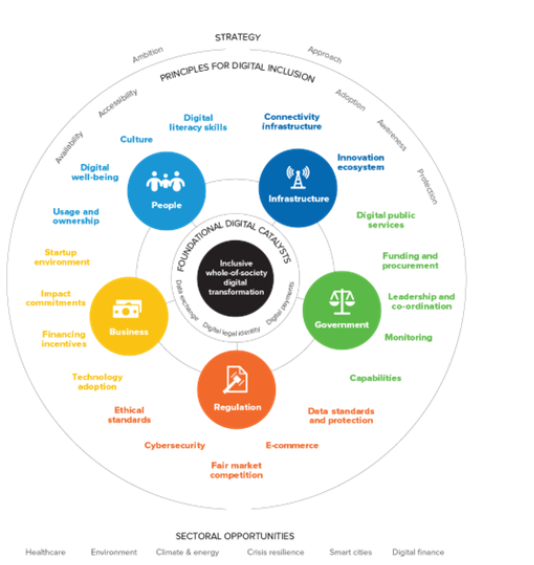 About PM-WANI
About PM-WANI
- PM-WANI, initiated by the Department of Telecom (DoT) in December 2020, is a significant program aimed at enhancing the accessibility of public WiFi hotspots to establish a robust digital communication network across the country, especially in rural areas.
- This framework enables various entities, such as shopkeepers, tea stall owners, or Kirana store owners, to establish public Wi-Fi hotspots and offer internet services to customers.
- PM-WANI aligns with the objectives outlined in the National Digital Communications Policy, 2018 (NDCP), which focuses on building a strong digital communications infrastructure.
Importance:
- To promote ease of doing business and encourage local businesses to provide Wi-Fi, it has been decided that last-mile Public Wi-Fi providers do not need licenses, registrations, or fees to the DoT.
PM-WANI Ecosystem:
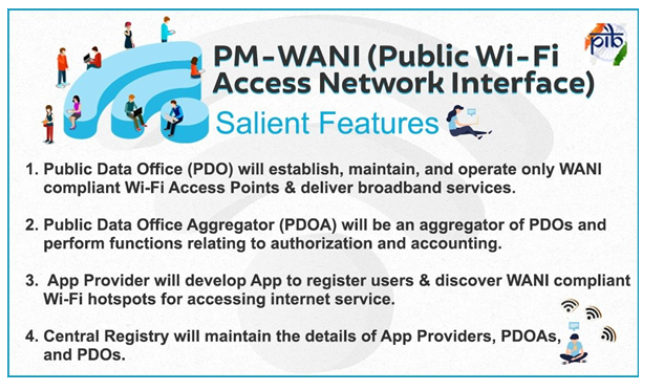 Status:
Status:
- As of November 2022, the PM-WANI central registry recorded 188 PDO aggregators, 109 app providers, and 11,50,394 public WiFi hotspots.
Benefits of PM-WANI:
- Expanding internet access in rural and remote areas.
- Offering an affordable and convenient alternative to internet access compared to expensive options like 5G.
- Encouraging innovation and competition in the internet market.
Challenges of PM-WANI:
- Ensuring Wi-Fi quality and user experience, involving bandwidth, user management, device compatibility, and data security.
- Addressing security concerns like data breaches, hacking, and malware.
- Potential challenges for mobile telecom companies regarding market share and revenue due to PM-WANI's affordability.
- Expanding and maintaining PM-WANI in areas with low internet demand and high operational costs.
PM-WANI as a Game-Changer for India’s Digital Public Infrastructure:
- PM-WANI is a vital component of India's Digital Public Infrastructure (DPI), making internet access more inclusive and bridging the digital divide.
- Leveraging existing physical and social infrastructure like shops, post offices, and schools to create a widespread network of Wi-Fi hotspots.
- Utilizing existing digital infrastructure, such as Aadhaar and UPI, for secure authentication and payment of Wi-Fi services.
- Empowering citizens and communities by granting access to information, knowledge, opportunities, and services, fostering participation in the digital economy and society.
Three Years of Abraham Accords
Why in News: The Abraham Accord between the United Arab Emirates, Bahrain and Israel has completed three years.
Abraham Accords:
- The Abraham Accord (2020), brokered by the USA, is a normalisation pact to establish formal diplomatic ties between the UAE and Israel.
- The name "Abraham Accords" was chosen as a sign of unity and as a reference to the historical figure of Abraham, who is said to be the ancestor of both Jews and Arabs.
- Bahrain, Sudan, and Morocco also joined the agreement, and in return Israel agreed to put a halt to its aspirations to annexe portions of the occupied West Bank.
- After Egypt (in 1979) and Jordan (1994), the UAE is the third Arab country to recognise Israel as a result of this agreement.
Significance of the Abraham Accords:
- The accord demonstrates how the Arab nations are rapidly disengaging from the Palestine issue.
- Israel, the United Arab Emirates, and Bahrain will establish full diplomatic connections, which will benefit the whole region.
- The agreement restores the UAE's reputation in the US, where its participation in the Yemen conflict has damaged it.
- Pakistan will be forced to choose between following the UAE's lead (which would be perceived as giving up the Islamic cause of Palestine) and not doing so (because it is already at odds with the Saudis over its refusal to take up the Kashmir issue and cannot afford another unfriendly Islamic country).
- Trade between Israel and other West Asian countries increased by 74% between 2021 and 2022.
- Tourism, mostly non-existent in the past, has skyrocketed. In 2021, visits from Israel to the UAE increased by 172%.
- In a region where 65% of the population is under 30 years of age, providing the younger generation with opportunities is a key factor in preventing instability.
- The Prosperity Green & Blue agreement between Israel, the UAE, and Jordan determined that a solar field to supply 600 megawatts of electricity to Israel and a desalination plant in Israel would deliver 200 million cubic meters of water to Jordan.
- The Abraham Accord encourages collaboration and education. The UAE incorporated Holocaust education into its school curriculum as a mandatory subject, fostering coexistence and religious tolerance.
India’s Interest:
- The Abraham Accords create the right conditions for India to forge closer connections with both Arab nations and Israel.
- As a result of the Abrahamic Accords, the formation of I2U2 was witnessed. Additionally, it was referred to informally as the "West Asian Quad" and the "Indo-Abrahamic construct."
- The coalition promotes collaboration in six sectors—food security, health, transportation, space, water, and energy.
- Collaboration between the three countries may result from Israel's inventive qualities, UAE financial support, and India's technological prowess. For example, Eccopia, an Israeli company with a manufacturing base in India, supported an Emirati project for a robotic solar panel.
- There are now convenient direct flights between Bahrain and Israel as well as the UAE, benefiting the expanding Indian diaspora in the Gulf.
- Indian students now have easier access to colleges, more opportunities to explore overseas education options, and greater travel convenience.
https://www.thehindu.com/opinion/op-ed/three-years-of-the-abraham-accords/article67327731.ece
Formation of Pink Diamond - Edukemy Current Affairs
Why in News: Recently, Western Australian scientists have connected formation of the pink diamond to the Earth’s first supercontinent (Vaalbara or Nuna) and events 1.3 billion years ago.
Pink diamond:
- Rare and highly coveted pink diamonds are distinguished by their exquisite pink or reddish-pink colour.
- Pink diamonds are quite uncommon, and because of their compelling beauty and rarity, they are worth a lot of money.
- Instead of impurities like nitrogen or boron, which give other coloured diamonds their colours (such as in the case of yellow and blue diamonds), pink diamonds have distinctive structural imperfections in the crystal lattice of the diamond.
Key findings of the Study:
- More than 90% of all the pink (and Red) diamonds ever found were discovered at the recently closed Argyle mine in the remote northwest of Australia.
- By measuring the age of elements in the crystals, the researchers determined that Argyle was 1.3 billion years old. That lines up with the break-up of the world’s first supercontinent, known as Nuna.
- Two of the three ingredients for forming pink diamonds had already been known.
- The first ingredient is carbon, and it must be more than 150 km deep.
- The second is just the right amount of pressure, to damage the otherwise clear diamonds.
- The missing (3rd) ingredient was the event (collisions between western Australia and northern Australia 1.8 billion years ago) that sent the diamonds shooting up to the surface along with the magma.
- Old mountain belts of Canada, Russia, southern Africa, and Australia are the possible locations where pink diamonds can be found.
Nuna supercontinent:
- The former supercontinent of Columbia, also known as Nuna or Hudsonland formerly existed on Earth.
- It is believed to have existed between 2,500 and 1,500 million years ago, during the Paleoproterozoic Era, as initially suggested by John J.W. Rogers and M. Santosh in 2002.
- Supercontinent assembly most likely took place between 2100 and 1800 million years ago, amid global-scale collisional episodes.
- The cores of the continents Laurentia, Baltica, the Ukrainian and Amazonian shields, Australia, and maybe Siberia, North China, and the Kalahari were built up of proto-cratons that made up Columbia.
- Geological and paleomagnetic findings support the presence of Columbia.
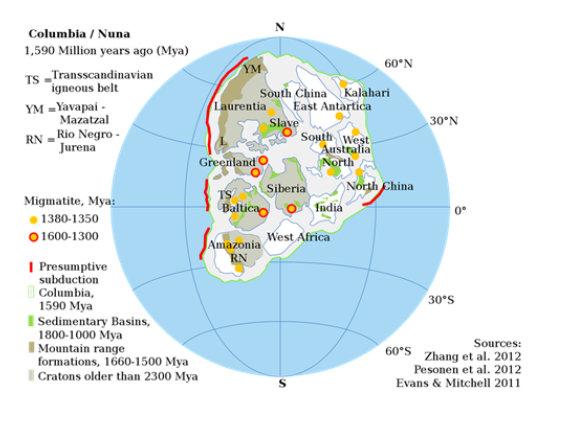
https://www.earth.com/news/pink-diamonds-were-formed-when-supercontinent-nuna-broke-up/
‘Bima Sugam’ online platform - Edukemy Current Affairs
Why in news? Recently, Insurance Regulatory and Development Authority of India (IRDAI) has formed a steering committee to act as the apex decision-making body for the creation of its ambitious ‘Bima Sugam’ online platform.
About:
Bima Sugam platform:
- Bima Sugam will be a ‘one-stop destination’ for people's insurance-related needs. These include services such as policies, portability facilities, change of agents, settling of claims, and more.
- Buyers can directly purchase life, motor, or health policies through web aggregators, brokers, banks, and insurance agents.
- Insurance companies will be major shareholders in the platform, which will offer services via an ‘e-insurance account’ (E-IA).
- Ownership:
- Life insurance and general insurance companies will own a 47.5 per cent stake each, while brokers and agent bodies will own 2.5 per cent each.
- Benefits of the portal:
- Act as a centralised database;
- Assist the insured/buyers in porting their respective policies based on coverage and pricing;
- Give people a wide choice to pick and choose policies and view all their policies;
- Reduce commission paid to intermediaries; and,
- Pave the way for a speedy acceptance of new/sandbox products.
| IRDAI: |
|
Mithun (‘Food Animal’) - Edukemy Current Affairs
In News: Recently, Northeast’s Mithun got a ‘food animal’ tag from the Food Safety and Standards Authority of India (FSSAI).
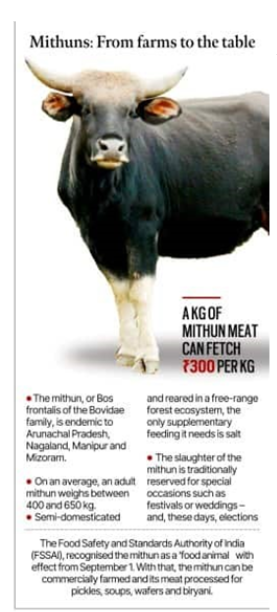 About:
About:
- Mithun is a ruminant species of the Bovidae family found in Arunachal Pradesh, Nagaland, Manipur and Mizoram.
- It is also the state animal of both Arunachal Pradesh and Nagaland.
- The Mithun or gayal (Bos frontalis) is considered a descendant of the Indian Gaur or bison.
- It is known as the ‘cattle of the mountain’.
- Characteristics:
- The mithun is semi-domesticated and is reared in a free-range forest ecosystem.
- Since the soil in these parts is acidic and low in salt content, mithuns have an affinity for salt.
- Conservation status
- IUCN: Vulnerable
- CITES: Appendix I.
- Initiatives:
- Indian Council of Agricultural Research (ICAR) has launched the M-ANITRA app to register mithun farmers as “buyers” and “sellers” with the aim to help them do business at competitive prices.
- Objective of recognition
- To help farmers and tribal village communities benefit commercially from the sale and processing of mithun meat.
- Other animals having food animal tag: Himalayan yak.
Tungareshwar Wildlife Sanctuary
In News: The Surya Regional Water Supply Project has achieved a milestone by completing the tunneling work of the Tungareshwar tunnel recently.
About:
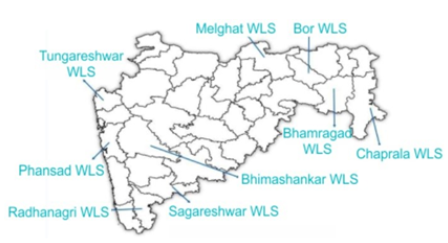
- Tungareshwar Wildlife Sanctuary also known as Tungareshwar National Park is located in the Palghar district of Maharashtra, 75 km away from Mumbai.
- The sanctuary forms a corridor between Sanjay Gandhi National Park and Tansa Wildlife Sanctuary.
- It is characterized by hilly terrain, dense forests, and small rivers or streams.
- Vegetation:
- There are three different types of forests – Dry Deciduous, Moist Deciduous and Semi Evergreen.
- Flora and Fauna:
- It is home to several species of trees, including teak, bamboo, and mango.
- Some commonly spotted animals in the sanctuary include Leopard, Wild Boar, Barking Deer, Langur, Bonnet and Rhesus Macaque, and Black-naped Hare.
- A multitude of birds, including the Crested Serpent-eagle, Jungle Owlet, White-eyed Buzzard, Oriental Honey-buzzard, Emerald Dove and Heart-spotted Woodpecker, can be found here.
- Temple:
- Several ancient temples are within its boundaries. The most famous of these temples is the Tungareshwar Temple, dedicated to Lord Shiva.
Vandanium Discovery in Gujarat
In News: Rare metal Vanadium, key for batteries, discovered in India’s Gujarat.
About
- Vanadium is a rare metal and a key raw material for many industrial applications. The metal has been found in the sediment samples collected from the Gulf of Khambhat, which opens into the Arabian Sea off Alang in Gujarat.
Application of Vandanium
- Enhancing Steel and Titanium Resilience:
- Vanadium is a significant metal in India due to its scarcity. It possesses the capability to improve the resilience and strength of steel and titanium alloys.
- Vanadium Redox Batteries (VRB) for Energy Storage:
- Modern applications of vanadium include its use in energy storage systems, particularly in VRBs. VRBs are utilized in various settings, including power plants and commercial applications.
- Unlimited Capacity with Sequentially Larger Tanks:
- VRBs offer the advantage of nearly unlimited capacity by using storage tanks of increasing size.
- Long-Term Discharge Tolerance:
- VRBs can be left completely discharged for extended periods without suffering any adverse effects.
- Rechargeability via Electrolyte Replacement:
- In cases where no power source is available for recharging, VRBs can be revitalized by simply replacing the electrolyte.
- Minimal Ecological Impact:
- VRBs are recognized for having the least ecological impact among all energy storage technologies. They contribute to more sustainable and environmentally friendly energy storage solutions.
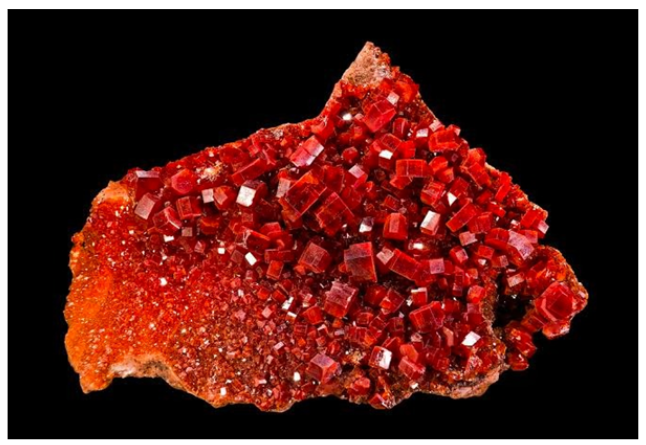
Adi Shankaracharya - Edukemy Current Affairs
In News: Recently, the Madhya Pradesh Chief Minister unveiled the 108-foot-tall ‘Statue of Oneness’ of Adi Shankaracharya at Omkareshwar.
About Adi Shankara:
- Adi Shankara, also known as Shankaracharya, was born on May 11th, 788 AD, in Kaladi near Kochi, Kerala.
- He attained Samadhi (spiritual liberation) at the age of 33 in Kedartirth.
- Adi Shankara was a devoted follower of Lord Shiva.
- He expounded the Doctrine of Advaita, which emphasizes the concept of Monism and wrote numerous Sanskrit commentaries on important Vedic texts such as the Upanishads, Brahma Sutras, and Bhagavad Gita.
- He held philosophical disagreements with Buddhist philosophers.
Major Works:
- Some of his major works include the "Brahmasutrabhasya," a commentary on the Brahma Sutra.
- He also composed the "Bhajagovinda Stotra," "Nirvana Shatakam," and several Prakaran Granths (philosophical treatises).
Other Contributions:
- Adi Shankara played a pivotal role in revitalizing Hinduism in India, especially during a time when Buddhism was gaining prominence.
- He established four Mathas (monastic institutions) in different corners of India, namely Shingeri, Puri, Dwaraka, and Badrinath, with the aim of propagating Sanathana Dharma (eternal religion).
Advaita Vedanta:
- Advaita Vedanta represents a philosophical stance characterized by radical nondualism, drawing its inspiration from ancient Upanishadic texts.
- According to Advaita Vedantins, the Upanishads unveil the fundamental concept of nonduality known as 'brahman,' which is the ultimate reality underlying all existence.
- Advaitins view Brahman as transcending individuality and the apparent diversity of the empirical world. They assert that the core essence of one's self (atman) is identical to Brahman.
- At the heart of Advaita Vedanta is the notion that atman is pure, non-intentional consciousness.

- It is described as singular, non-dual, infinite, and in complete unity with Brahman, lacking any separation or distinction.
Immunity of legislators from bribery charges
In News: Recently, the Supreme Court has forwarded the question of whether legislators' legal immunity provided by Article 105(2) and 194(2) of the Constitution protects them from criminal prosecution in cases involving the offering or acceptance of a bribe to a seven-judge bench for consideration.
About
Article 105 of the Constitution:
- Article 105 deals with the "powers, privileges, etc. of the Houses of Parliament and of the members and committees thereof."
Article 105(2) of the Constitution:
- Article 105(2) states that no member of Parliament shall be subject to any legal proceedings in any court for anything said or any vote cast by them in Parliament or any of its committees.
- Additionally, no individual can be held liable for the publication, made under the authority of either House of Parliament, of any report, paper, votes, or proceedings.
Extension of Immunity under Article 105:
- This legal immunity extends not only to members of Parliament but also to certain non-members who participate in parliamentary proceedings, such as the Attorney General of India or a Minister who may not be a member but delivers speeches in the House.
Power of the Speaker:
- In cases where a member's speech or actions exceed the permissible boundaries of free speech, the Speaker of the House holds the authority to address such matters.
Article 194(2) of the Constitution:
- Article 194(2) extends the same immunity provided by Article 105(2) to Members of Legislative Assemblies (MLAs) in the states. This means that state legislators, like their counterparts in Parliament, are protected from legal proceedings in connection with their statements or votes within the state legislative bodies.
Current Legal Issue:
- The central question in the present case before the court is whether the legal immunity granted to parliamentarians and state legislators under Article 105(2) and Article 194(2) extends to protect them from prosecution in cases involving the demand for or acceptance of a bribe.
Gap Between Law and Justice - Edukemy Current Affairs
Exam View: Criminal laws in India; Basis of criminal laws: Universal individualism; Ignored in criminal laws: Social production; Need for reimagining the criminal justice system; Way forward.
Context: The Indian Penal Code, 1860 will be replaced by the Bharatiya Nyaya Sanhita Bill, 2023, the Criminal Procedure Code, 1898 will be replaced by the Bharatiya Nagarik Suraksha Sanhita Bill, 2023 and the Indian Evidence Act, 1872 will be replaced by the Bharatiya Sakshya Bill, 2023.
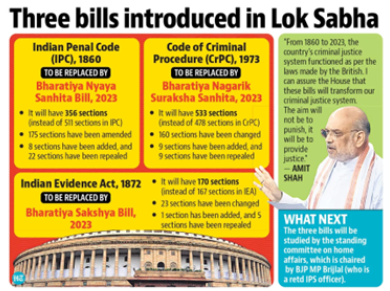 Decoding the editorial: Criminal laws in India
Decoding the editorial: Criminal laws in India
- Strengthening law and order is the intended aim of the new bills, according to the statement of objects and reasons.
- The Bills assume that the law can maintain “public order” by reducing crimes.
Basis of criminal laws: Universal individualism
- The system of criminal law in India is premised on the idea of Universal individualism.
- Under this, the responsibility for crimes lies solely with individual offenders.
- It universally ascribes free will and complete autonomy to all individuals over their decisions, irrespective of their social context.
- But the role of criminal law in achieving this goal is often exaggerated.
- With its exclusive focus on blaming and punishing individual offenders for crimes, criminal law obscures the socially rooted nature of crimes.
Ignored in criminal laws: Social production
- A person’s decision making process and their ability to cope with risks is greatly influenced by their environmental factors.
- Environmental factors like socio-economic status, social upbringing, education, family and friendships, interact with individual psychological and biological factors and influence individual responses to different situations.
- Understanding the dynamics of the social production of crime raises difficult questions about the obsessive and singular focus of criminal law on individual criminal responsibility.
- In fact, the continued prevalence of many crimes is deeply influenced by the socio-cultural realities of our society.
- For instance, the rape culture in our society is a constant and violent reminder of this dynamic.
Need for reimagining the criminal justice system
- The main purpose of the law and order discourse is “demonstrative rather than substantive.”
- Adopting the legislative reform route offers the illusion of strict action from the state without any worthwhile and long-term efforts towards addressing real problems that plague the criminal justice system.
- The potential of criminal law is grossly overstated as it routinely blames individual for crimes.
- It also hides the operations of power that characterise criminal justice administration.
- Along with selective criminalisation and arbitrary application, the disproportionate impact of the force of criminal law on the poor, the vulnerable and the powerless is well-documented across the world and India is no exception to that.
- Therefore, any claims about the neutrality of criminal law and its administration is suspect.
- The strenuous tensions between law and justice play out in violent terms in the context of criminal law.
Way forward
- Invoke the framework of “criminal justice” rather than the significantly narrower idea of “criminal law”.
- The legislative reforms can play an extremely limited role in preventing crimes and strengthening law and order.
- The law, by itself, can deliver very little of the reforms we need.
- Fundamentally reconfigure institutions that play a role in delivering criminal justice.
- A reconfiguration that is sufficiently invested in fairness, justice, and being effective for both victims and accused persons.
- Our system fails victims and survivors as much as it fails accused persons and mere legislative changes will not change that.
- The institutional imagination of our police, investigation mechanisms, criminal courts, prosecution and defence services, prisons, and support services in criminal justice administration needs urgent and fundamental reconsideration if we are truly interested in an “overhaul”.
Apart from that widespread textual borrowing, there is no overhaul in the approach to criminal law or criminal justice that the new Bills seek to usher in. The empty rhetoric of “overhaul” and “decolonisation” seek to convey something that these Bills come nowhere close to delivering.
Source: https://indianexpress.com/article/opinion/columns/gap-between-law-and-justice-8954360/
Share the article
Edukemy’s Current Affairs Quiz is published with multiple choice questions for UPSC exams
MCQ
Get Latest Updates on Offers, Event dates, and free Mentorship sessions.

Get in touch with our Expert Academic Counsellors 👋
FAQs
UPSC Daily Current Affairs focuses on learning current events on a daily basis. An aspirant needs to study regular and updated information about current events, news, and relevant topics that are important for UPSC aspirants. It covers national and international affairs, government policies, socio-economic issues, science and technology advancements, and more.
UPSC Daily Current Affairs provides aspirants with a concise and comprehensive overview of the latest happenings and developments across various fields. It helps aspirants stay updated with current affairs and provides them with valuable insights and analysis, which are essential for answering questions in the UPSC examinations. It enhances their knowledge, analytical skills, and ability to connect current affairs with the UPSC syllabus.
UPSC Daily Current Affairs covers a wide range of topics, including politics, economics, science and technology, environment, social issues, governance, international relations, and more. It offers news summaries, in-depth analyses, editorials, opinion pieces, and relevant study materials. It also provides practice questions and quizzes to help aspirants test their understanding of current affairs.
Edukemy's UPSC Daily Current Affairs can be accessed through:
- UPSC Daily Current Affairs can be accessed through Current Affairs tab at the top of the Main Page of Edukemy.
- Edukemy Mobile app: The Daily Current Affairs can also be access through Edukemy Mobile App.
- Social media: Follow Edukemy’s official social media accounts or pages that provide UPSC Daily Current Affairs updates, including Facebook, Twitter, or Telegram channels.

